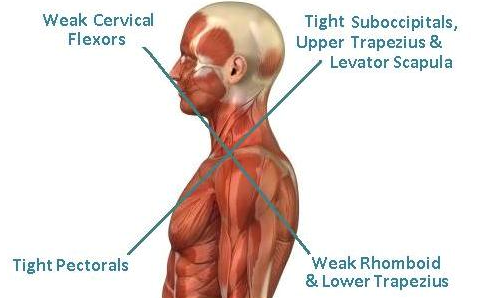|
From a young age, we are always told by our parents to “stand up straight!” “Don't slouch!” As we get older, we lose those constant reminders from our parents and forget to correct our posture falling back into old habits of slouching. We are also using a computer more often than ever before, and we are often in a seated position. Over time this has a detrimental effect on our body, particularly the neck. Furthermore, technology while extremely beneficial in a lot of ways can also cause physical pain if used too much. For example, using our smartphones on a regular basis. When we’re walking and texting at the same time, playing a game on our phones, or catching up on social media we assume a bad posture, a posture of looking down. The longer we stay looking down at our phones, the more tired our muscles will become. Look how easily changing the angle of our posture effects how much harder or easier our muscles must work. I’d be lying if I told you that I was never in a bad position like this before. However, it is about how long we spend in these poor postures. If we accidentally fall into bad posture, we just need to be conscious of it and try not to stay in that position for long. As we spend more time in this posture, our body adapts in a not so pleasant way. The upper fibers of the trapezius muscle start to become chronically tight as well as our pectoral muscles, which are main muscles of the chest. What also happens is the deep muscles on the front of our neck, as well as the lower fibers of the trapezius, become inhibited. With this inhibition, it allows us to assume a bad posture more often which leads to even more pain. This postural condition is known as upper cross syndrome and can we can understand why it is called this with the following picture. As you can see, the tight muscles form a straight line through the neck, and the weakened, or inhibited muscles also form a straight line through the neck. Vladimir Janda first recognized this postural condition in the 1980’s. Janda noted that over time with increased muscle activation in these areas, the muscles had a lower threshold for activity. Meaning, that any movement in the slightest could cause these muscles to fire inadvertently and cause movement dysfunction, which could lead to even more pain.
The goal then is to decrease the tightness and increase strength and endurance in the weak and inhibited muscles. Some simple things you can try at home to help are: 1. Stretch the upper fibers of your trapezius muscle by tilting your head to the side, then taking your hand on the same side you are leaning towards and place it on the top of your head. Encourage the stretch by moving your head with the assistance from your hand. Do this to both sides, but DO NOT overstretch! It should be a comfortable stretch and not painful. 2. Stand in a doorway. Place the hand flat against the doorway with the shoulder to be stretched away from your body (at a 90-degree angle or parallel with the floor). Now place the inside of the bent arm on the surface of the wall. Gently lean in till you feel a comfortable stretch. If you do not feel the stretch, try moving your elbow up or down in the doorway and see if you can find the tight spot. 3. Start to strengthen the lower fibers of your trapezius by assuming a good posture. Draw your shoulder blades together and then bring them downwards, imagining that you are trying to put your shoulder blades in your rear pockets. You should feel a light stretch in your upper trapezius muscle if you are doing this correctly. 4. Finally, strengthen your deep muscles on the front of your neck by tucking your chin in to your throat and give yourself a “double chin.” This exercise will activate the deepest muscles in your neck. If these exercises seem over confusing, or too easy make sure to book an appointment with your chiropractor to help give you guidance. Especially if you are currently experiencing pain, see a chiropractor first to help minimize the pain and then begin the exercises. Reference Janda Syndromes Janda Syndromes. (2010). The Janda Approach. Retrieved 3 December 2016, from http://www.jandaapproach.com/the-janda-approach/jandas-syndromes/
5 Comments
|
Dr. Ken AlexanderDr. Ken Alexander is a Chiropractor at Remedy Wellness Centre in Victoria. Archives
October 2017
Categories |
Remedy Wellness Centre214-852 Fort St.
Victoria, BC V8W 1H8 |
HoursM-F: 8am - 7pm
S: 9am - 3pm |
Phone |




 RSS Feed
RSS Feed